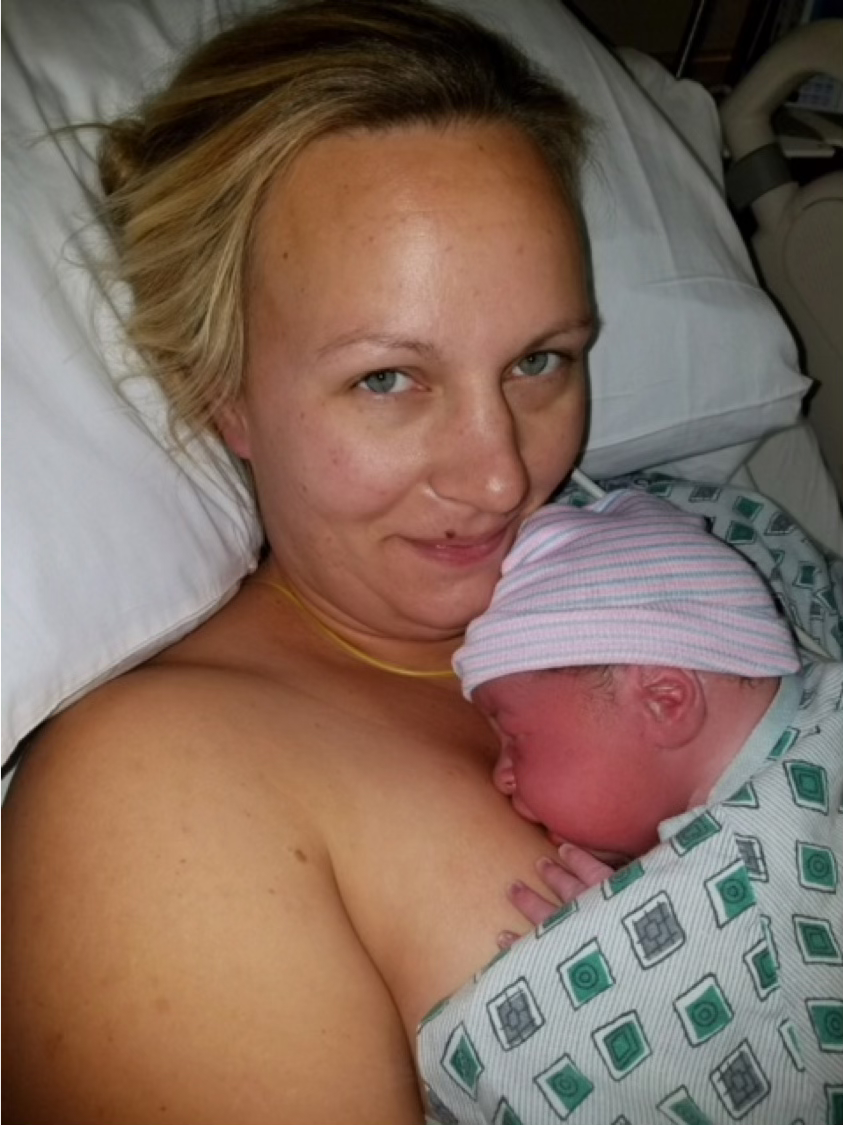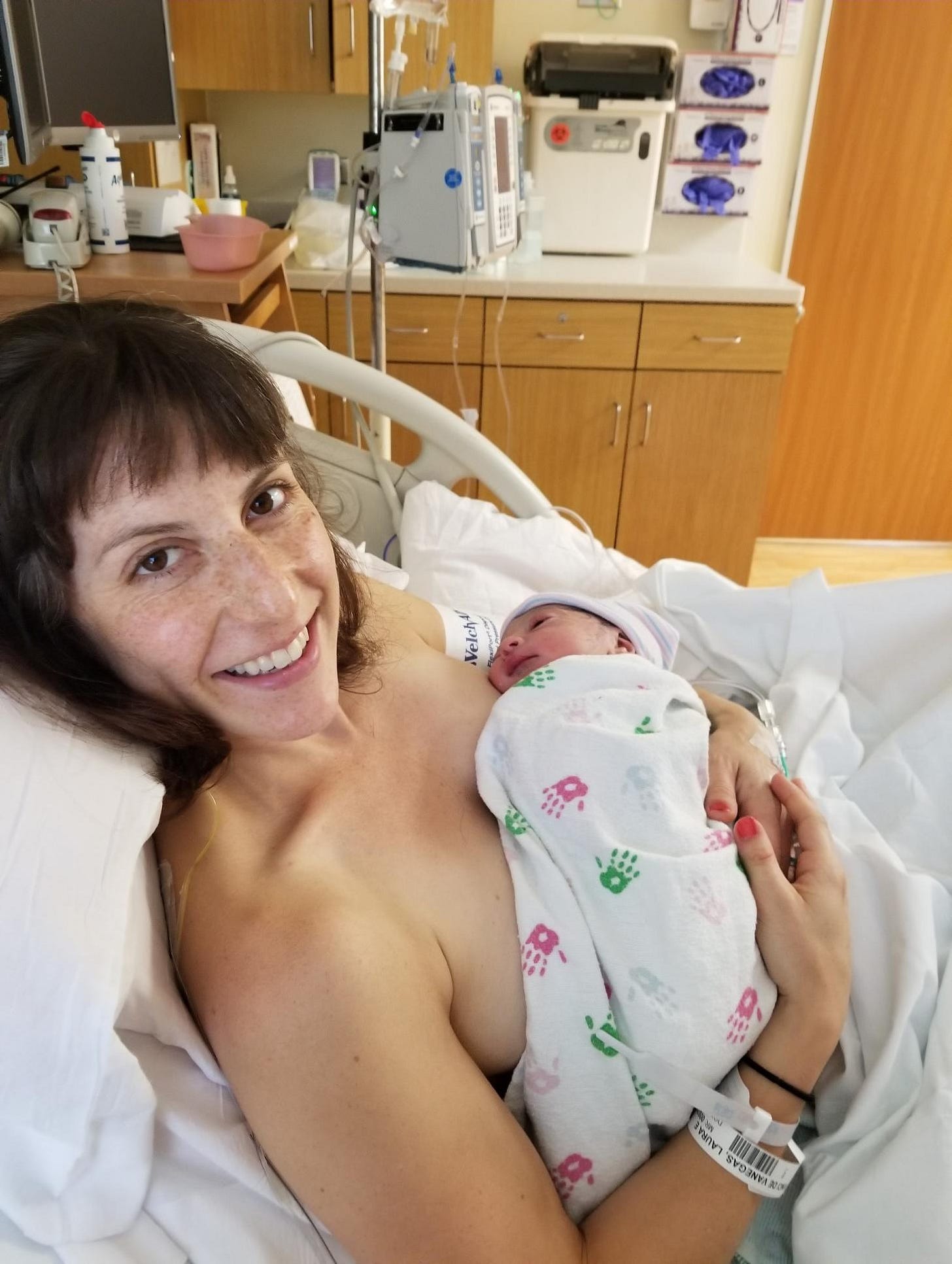Step 4 of the Ten Steps to Successful Breastfeeding is the skin-to-skin step.
Step 4 reads, “Facilitate immediate and uninterrupted skin-to-skin contact and support mothers to initiate breastfeeding as soon as possible after birth.”
Skin-to-skin contact is when the infant is placed prone on the mother’s abdomen or chest with no clothing separating them. To clarify, immediately after birth, an infant may be on the abdomen until the cord is clamped and cut. Then the infant moves him/herself or is moved to the chest, atop the sternum. (1)
The infant should be placed skin-to-skin with the mother immediately after birth and remain there without interruption for at least 60 minutes or longer if the mother wishes and/or the infant needs more time to complete a breastfeed. Staff should assist the mother. If the mother’s plan is not to breastfeed, or if breastfeeding is contraindicated, the mother should hold her baby in skin-to-skin contact for at least an hour immediately after birth. (1)
Question #1. Why is skin-to-skin holding immediately after birth important?
Answer: Skin-to-skin contact immediately after birth is important because it:
Promotes bonding
Helps breastfeeding
Is associated with less infant crying
Stabilizes the infant’s sugar (glucose) level
Regulates the infant’s vital signs: heart rate, respiratory rate and temperature
Normalizes a cesarean birth.
Question #2. After a vaginal birth, when should skin-to-skin be initiated and for how long should it last?
Answer: It should be immediate and uninterrupted until the first breastfeed, or for an hour for the formula feeding mother, or for as long as the mother wishes.
Question #3. After a Cesarean birth, when should skin-to-skin contact be initiated?
Answer: It should happen as soon as the mother is stable and able to respond. Once skin-to-skin holding is started, it should be uninterrupted for an hour.
Question #4. What if the mother doesn’t want to breastfeed?
Answer: Skin-to-skin holding for at least one hour is recommended for all babies.
Question #5. What if the baby is sick and needs extra attention?
Answer: Safety first. Once the infant is stable, the baby should be returned to the mother for skin-to-skin holding and then it should occur for an uninterrupted hour or until the first feed.
Question #6. What if the mother is sick after birth?
Answer: Again, safety first. The baby’s father or other support person can be encouraged to hold the baby skin-to-skin. This might happen in the delivery room, in the operating room, or in the nursery. Once again, once skin-to-skin starts, it should last for an uninterrupted hour.
Question #7. Should safe skin-to-skin holding be encouraged throughout the maternity stay.
Answer: Yes.
Question #8. What impact does breastfeeding in the first hour of life have on the duration of breastfeeding?
Answer: Research shows that infants who breastfeed in the first hour of life have a better suck and increased breastfeeding duration compared with infants whose first breastfeeding is delayed.
Question #9. What are the nine distinct stages of innate newborn behavior when an infant is placed on the mother’s abdomen? (2)
Answer:
The birth cry
Relaxation (Lasting 2-3 minutes, baby is very quiet and still.)
Awakening (At about 3 minutes, head and shoulders move, may open eyes and make small mouthing movements.)
Activity (At about 8 minutes, eyes remain open, may look for mother, increased mouthing and sucking, drooling)
Resting (Resting may occur at any point.)
Crawling (At about 20 minutes, baby begins to approach the breast by leaping, crawling, sliding, and/or pushing. The kicking motion of the feet may help deliver the placenta. Baby continues mouthing and suckling movements although baby is not ready to latch.)
Familiarization (At about 45 minutes, baby may lick, touch or massage the breast while looking at the mother.)
Suckling (At about 60 minutes, baby self-attaches to the nipple and begins to suck with minimal or no assistance.)
Then mother and baby go into a deep sleep.
“Being skin-to-skin with the mother immediately after birth is much more than a nice way to be welcomed into the world. The first hour after birth is a once-in-a-lifetime occasion for both the baby and the parents. It is a “sacred hour,” during which a family is formed…Something special happens during the first hour after birth…Thus, it is a time that should be honored, cherished, and protected whenever possible.” (2)
References
Baby-Friendly USA, Inc. Guidelines and Evaluation Criteria for Facilities Seeking Baby-Friendly Designation, Sixth Edition. Albany, NY: Baby-Friendly USA, 2021.
Phillips R. The sacred hour: Uninterrupted skin-to-skin contact immediately after birth. Newborn and Infant Nursing Reviews. 2013;13:67-72.
Tema #29. La Iniciativa Amigos del Niño Parte 2: Paso 4
El paso 4 de los Diez Pasos para una Lactancia Materna Exitosa es el paso piel con piel.
El paso 4 dice: "Facilitar el contacto piel a piel inmediato e ininterrumpido y apoyar a las madres para que inicien la lactancia materna lo antes posible después del nacimiento".
El contacto piel con piel se produce cuando el bebé se coloca boca abajo sobre el abdomen o el pecho de la madre, sin ropa que los separe. Aclaración: inmediatamente después del nacimiento, el bebé puede permanecer boca abajo hasta que se pinza y se corta el cordón umbilical. Luego, el bebé se mueve solo o se le coloca sobre el pecho, encima del esternón. (1)
El bebé debe colocarse en contacto piel con piel con la madre inmediatamente después del nacimiento y permanecer allí sin interrupción durante al menos 60 minutos o más si la madre lo desea o si el bebé necesita más tiempo para completar la toma. El personal debe asistir a la madre. Si la madre no planea amamantar, o si la lactancia materna está contraindicada, debe mantener a su bebé en contacto piel con piel durante al menos una hora inmediatamente después del nacimiento. (1)
Pregunta #1. ¿Por qué es importante el contacto piel con piel inmediatamente después del nacimiento?
Respuesta: El contacto piel con piel inmediatamente después del nacimiento es importante porque
Promueve el vínculo afectivo;
Ayuda a la lactancia materna;
Se asocia a un menor tiempo de llanto del bebé;
Estabiliza el nivel de azúcar (glucosa) del bebé;
Regula las constantes vitales del bebé: ritmo cardíaco, frecuencia respiratoria y temperatura; y
Normaliza un parto por cesárea.
Pregunta #2. Después de un parto vaginal, ¿cuándo debe iniciarse el contacto piel con piel y cuánto tiempo debe durar?
Respuesta: Debe ser inmediato e ininterrumpido hasta la primera toma de pecho, o durante una hora en el caso de la madre que alimenta con fórmula infantil, o durante el tiempo que la madre desee.
Pregunta #3. Después de un parto por cesárea, ¿cuándo debe iniciarse el contacto piel con piel?
Respuesta: Debe producirse tan pronto como la madre esté estable y pueda responder. Una vez iniciado el contacto piel con piel, debe continuar ininterrumpido durante una hora.
Pregunta #4. ¿Qué pasa si la madre no quiere amamantar?
Respuesta: Se recomienda mantener el contacto piel con piel durante al menos una hora para todos los bebés.
Pregunta #5. ¿Y si el bebé está enfermo y necesita más atención?
Respuesta: Una vez que el bebé esté estable, se le debe devolver a la madre para que lo sostenga piel con piel y entonces se debe hacer durante una hora ininterrumpida o hasta la primera toma. La seguridad debe ser siempre lo primero.
Pregunta #6. ¿Qué ocurre si la madre está enferma después del parto?
Respuesta: Se puede animar al padre del bebé o a otra persona de apoyo a que sostenga al bebé piel con piel. Esto puede ocurrir en la sala de partos, en el quirófano o en el retén de niños sanos. En este caso el contacto piel con piel también debe durar una hora ininterrumpida.
Pregunta #7. ¿Debería fomentarse el contacto seguro piel con piel durante toda la estancia de maternidad?
Respuesta: Sí.
Pregunta#8. ¿Qué impacto tiene la lactancia materna en la primera hora de vida sobre la duración de la lactancia?
Respuesta: Las investigaciones demuestran que los bebés que toman el pecho en la primera hora de vida succionan mejor y tienen una mayor duración de la lactancia en comparación con los bebés cuya primera toma se retrasa.
Pregunta #9. ¿Cuáles son las nueve etapas instintivas del comportamiento innato del recién nacido cuando se le coloca sobre el abdomen de la madre?
Respuesta:
Llanto al nacer.
Relajación (Dura 2-3 minutos, el bebé está muy tranquilo y quieto).
Despertar (A los 3 minutos aproximadamente, la cabeza y los hombros se mueven, puede abrir los ojos y hacer pequeños movimientos con la boca).
Actividad (A los 8 minutos aproximadamente, los ojos permanecen abiertos, puede buscar a la madre, aumenta la succión y los movimientos con la boca, babeo).
Descanso (El descanso puede producirse en cualquier momento).
Arrastre (A los 20 minutos aproximadamente, el bebé empieza a acercarse al pecho saltando, gateando, deslizándose y/o empujándose. El movimiento de patada de los pies puede ayudar a expulsar la placenta. El bebé continúa con los movimientos de boca y de succión, aunque no está preparado para agarrarse al pecho).
Familiarización (A los 45 minutos aproximadamente, el bebé puede lamer, tocar o masajear el pecho mientras mira a la madre).
Succión (A los 60 minutos aproximadamente, el bebé se engancha al pezón y empieza a succionar con una ayuda mínima o sin ella).
A continuación, la madre y el bebé entran en un sueño profundo.
"Estar piel con piel con la madre inmediatamente después del nacimiento es mucho más que una forma agradable de ser recibido en el mundo. La primera hora después del nacimiento es una ocasión única en la vida tanto para el bebé como para los padres. Es una "hora sagrada", durante la cual se forma una familia... Algo especial sucede durante la primera hora después del nacimiento... Por lo tanto, es un momento que debe ser honrado, apreciado y protegido siempre que sea posible." (2)
Referencias
Baby-Friendly USA, Inc. Guidelines and Evaluation Criteria for Facilities Seeking Baby-Friendly Designation, Sixth Edition. Albany, NY: Baby-Friendly USA, 2021.
Phillips R. La hora sagrada: contacto ininterrumpido piel con piel inmediatamente después del nacimiento. Reseñas de enfermería para recién nacidos y lactantes. 2013;13:67-72.








